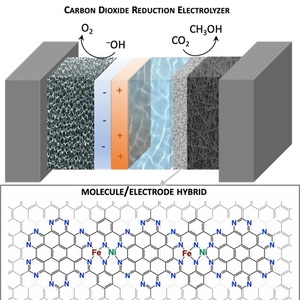DOE: National labs research better uses for CO2

SOURCE: Argonne National Laboratory
January 23, 2023
BY U.S. Department of Energy
According to the National Oceanic and Atmospheric Administration (NOAA), the global average for atmospheric carbon dioxide (CO2) set a record in 2021. The annual rate of CO2 emissions increase over the past 60 years is about 100 times faster than previous natural releases, such as those that occurred at the end of the last ice age 11,000 to 17,000 years ago. Primarily, this rapid increase is due to human-driven activities. Carbon utilization technologies can help reduce those emissions.
A collaborative team of U.S. Department of Energy Bioenergy Technologies Office (BETO)-funded scientists from Argonne National Laboratory (ANL) and National Renewable Energy Laboratory (NREL) are examining how to make better use of CO2 generated by industry, transportation, and agriculture by turning it into sustainable aviation fuel and other useful products.
It’s difficult to lower the oxidation state of the carbon atom, and one of the major hurdles associated with reductive CO2 utilization is in the initial step of carbon activation. BETO and partners are working to develop technologies that efficiently convert reduced forms of carbon into affordable biofuels and bioproducts.
Advertisement
The project is led by Ksenia Glusac, who holds an appointment in chemical sciences and engineering at ANL and is a professor of chemistry at the University of Illinois, Chicago. With colleagues Deborah Myers and Peter Zapol of ANL and Wilson Smith of NREL, Glusac is using a two-step approach to find new uses for carbon dioxide. In the first step, using electrochemical methods, the Glusac team converts carbon dioxide into methanol, the ANL team focuses on catalyst development, and the NREL team works on electrolyzer assembly and scale-up. Afterwards, other researchers at the national laboratories upgrade the methanol into fuels by feeding it microorganisms and algae. The goal is to identify catalysts that can make beneficial products (such as an aviation fuel) efficiently and selectively.
The novelty of the research is exciting for a couple of reasons. By fine-tuning diverse molecular building blocks, the Glusac team is designing catalysts with molecular electrodes that exhibit high selectivity toward methanol. This approach is important, since carbon dioxide can be converted into a myriad of valuable products, such as fuels, chemicals, plastics, and materials from carbon resources.
Additionally, the research explores the diverse possibilities of methanol, which has rich potential for uses that contribute to lower greenhouse gas emissions and help in the fight against climate change. Methanol can generate electricity when used for fuel cells and can be used as a heating fuel for boilers or as a sustainable or blended fuel for road, marine, or (potentially) aviation applications. Additionally, methanol is used as a chemical industry feedstock for the synthesis of formaldehyde, acetic acid, and other health and life sciences products. While there are carbon emissions from the production of methanol from CO2, they can be significantly lower than those associated with fossil fuels when renewable electricity is used during the process.
Advertisement
“A net-zero greenhouse gas economy of the future will still need carbon-based fuels and chemicals,” said BETO Director Dr. Valerie Sarisky-Reed. “This research will expand the resource pool of renewable carbon that can be leveraged to meet those needs. Making renewable methanol from CO2 and electricity provides an innovative route to a host of fuels and products."
The long-term challenge of this exciting research will be scaling up scientific findings into commercial applications. With atmospheric carbon dioxide levels on the rise, innovative research that finds ways to transform CO2 in the atmosphere into something positive is more important than ever.
Related Stories
The USDA reduced its outlook for 2024-’25 soybean oil use in biofuel production in its latest World Agricultural Supply and Demand Estimates report, released April 10. The outlook for soybean oil pricing was revised up.
BDI-BioEnergy International has signed a contract with Ghent Renewables BV to begin the construction of a pioneering biofuel feedstock refinery plant. Construction is underway and the facility is expected to be operational by the end of 2025.
Gevo subsidiary announces agreement with Minnesota Soybean Processors to track and verify sustainable agriculture attributes
Verity Holdings LLC, a subsidiary of Gevo Inc., has partnered with Minnesota Soybean Processors (MnSP) to implement Verity’s proprietary track and trace software. The collaboration aims to unlock additional value through export premiums.
U.S. operatable biofuels capacity increased slightly in January, with gains for ethanol, according to the U.S. EIA’s Monthly Biofuels Capacity and Feedstock Update, released March 31. Feedstock consumption was down when compared to December.
U.S. farmers are expected to plant 83.5 million acres of soybeans in 2025, down 4% when compared to last year, according to the USDA National Agricultural Statistics Service’s annual Prospective Plantings report, released March 31.
Upcoming Events









